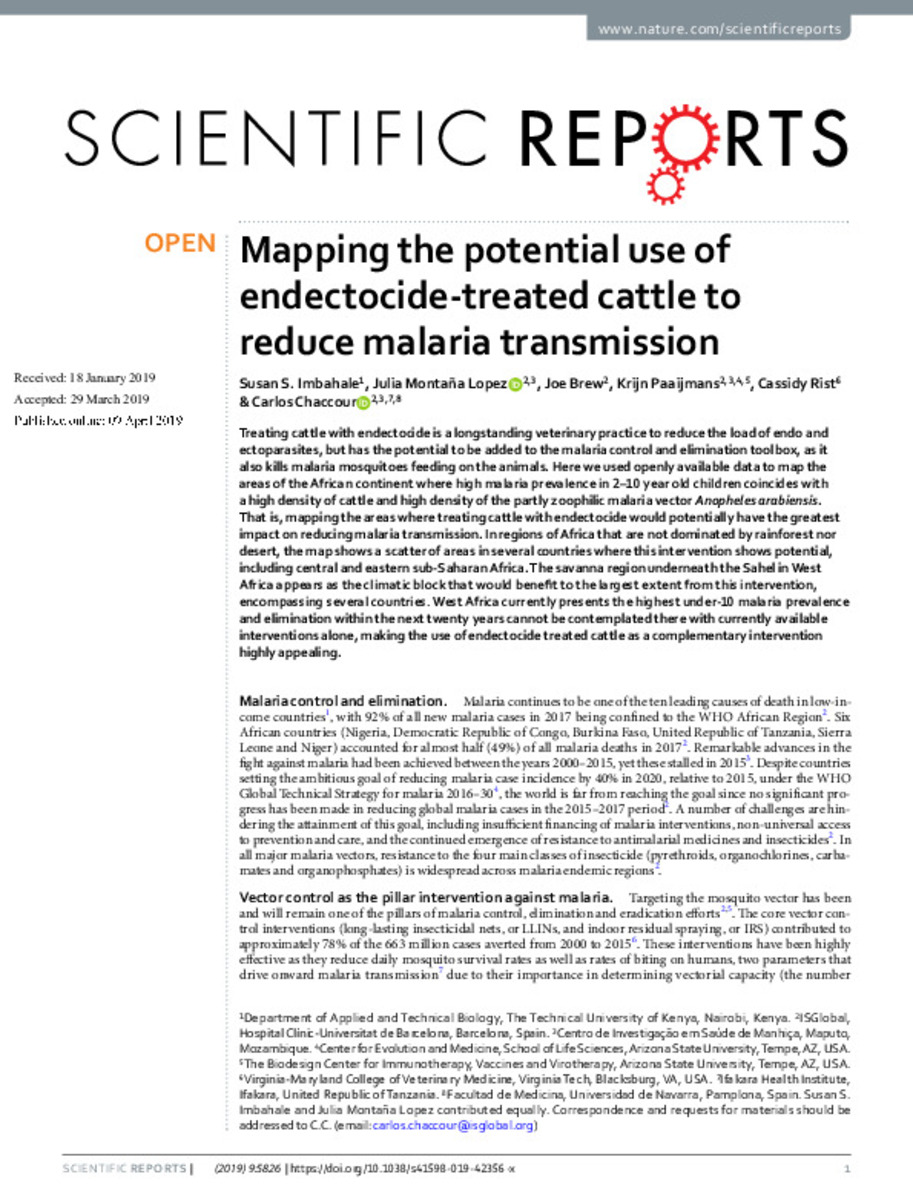Full metadata record
| DC Field | Value | Language |
|---|---|---|
| dc.creator | Imbahale, S.S. (Susan S.) | - |
| dc.creator | Montaña-López, J. (Julia) | - |
| dc.creator | Brew, J. (Joe) | - |
| dc.creator | Paaijmans, K. (Krijn) | - |
| dc.creator | Rist, C. (Cassidy) | - |
| dc.creator | Chaccour, C.J. (Carlos J.) | - |
| dc.date.accessioned | 2021-10-04T11:10:15Z | - |
| dc.date.available | 2021-10-04T11:10:15Z | - |
| dc.date.issued | 2019 | - |
| dc.identifier.citation | Imbahale, S.S. (Susan S.); Montaña-López, J. (Julia); Brew, J. (Joe); et al. "Mapping the potential use of endectocide-treated cattle to reduce malaria transmission". Scientific Reports. 9 (5826), 2019, 1 - 9 | es |
| dc.identifier.issn | 2045-2322 | - |
| dc.identifier.other | PMID: 30967606 | - |
| dc.identifier.uri | https://hdl.handle.net/10171/62144 | - |
| dc.description.abstract | Treating cattle with endectocide is a longstanding veterinary practice to reduce the load of endo and ectoparasites, but has the potential to be added to the malaria control and elimination toolbox, as it also kills malaria mosquitoes feeding on the animals. Here we used openly available data to map the areas of the African continent where high malaria prevalence in 2-10 year old children coincides with a high density of cattle and high density of the partly zoophilic malaria vector Anopheles arabiensis. That is, mapping the areas where treating cattle with endectocide would potentially have the greatest impact on reducing malaria transmission. In regions of Africa that are not dominated by rainforest nor desert, the map shows a scatter of areas in several countries where this intervention shows potential, including central and eastern sub-Saharan Africa. The savanna region underneath the Sahel in West Africa appears as the climatic block that would benefit to the largest extent from this intervention, encompassing several countries. West Africa currently presents the highest under-10 malaria prevalence and elimination within the next twenty years cannot be contemplated there with currently available interventions alone, making the use of endectocide treated cattle as a complementary intervention highly appealing. | es_ES |
| dc.description.sponsorship | ISGlobal is a member of the CERCA Programme, Generalitat de Catalunya. Carlos Chaccour is supported by a Ramón Areces fellowship. Joe Brew is supported by an Erasmus Mundus Joint Doctorate Fellowship, Specifc Grant Agreement 2016-1346. | es_ES |
| dc.language.iso | eng | es_ES |
| dc.publisher | Springer Science and Business Media LLC | es_ES |
| dc.rights | info:eu-repo/semantics/openAccess | es_ES |
| dc.subject | Materias Investigacion::Ciencias de la Salud::Enfermedades | es_ES |
| dc.title | Mapping the potential use of endectocide-treated cattle to reduce malaria transmission | es_ES |
| dc.type | info:eu-repo/semantics/article | es_ES |
| dc.description.note | This article is licensed under a Creative Commons Attribution 4.0 International License, which permits use, sharing, adaptation, distribution and reproduction in any medium or format, as long as you give appropriate credit to the original author(s) and the source, provide a link to the Creative Commons license, and indicate if changes were made. | es_ES |
| dc.identifier.doi | 10.1038/s41598-019-42356-x | - |
| dadun.citation.endingPage | 9 | es_ES |
| dadun.citation.number | 5826 | es_ES |
| dadun.citation.publicationName | Scientific Reports | es_ES |
| dadun.citation.startingPage | 1 | es_ES |
| dadun.citation.volume | 9 | es_ES |
Files in This Item:
Statistics and impact
Items in Dadun are protected by copyright, with all rights reserved, unless otherwise indicated.






